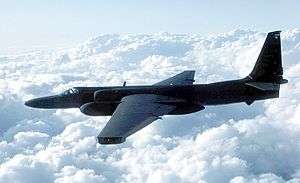United States aerial reconnaissance of the Soviet Union

Between 1946 and 1960, the United States Army Air Forces conducted aerial reconnaissance flights over the Soviet Union in order to determine the size, composition, and disposition of Soviet forces. Aircraft used included the Boeing B-47 Stratojet bomber and, from 1956, the Lockheed U-2 plane specifically designed for high-altitude reconnaissance. The program was ended following the U-2 incident of 1960.
Background
Reconnaissance flights began in 1946 along the borders of the Soviet Union and other Socialist Bloc states. The necessity of peacetime overflights was reinforced after the escalation of the Cold War in the late 1940s and, in particular, after the Korea War started in 1950. US President Harry S. Truman authorized selected overflights of the Soviet Union in order to determine the status of its air forces. It was feared that the Soviets might launch a surprise aerial attack on the United States with long-range bombers.[1]:91-92
First flights
In 1952 a modified B-47B bomber made the first deep-penetration U.S. overflight of Soviet territory to photograph Siberian air bases. Limited periphery flights had been conducted by US aircraft, including the Electronics intelligence RB-29, RB-50 and RB-47. Overflights of the Soviet Union with the newly designated RB-47Es started in 1954, often at great risk, as they were routinely intercepted by Soviet MiGs. It became apparent that a new aircraft was needed that could operate at altitudes well above any Soviet air defenses.[1]
U-2 missions
In November 1954, President Dwight D. Eisenhower approved a secret program under the direction of the CIA to build and fly a special-purpose high-altitude reconnaissance aircraft named Project AQUATONE. Lockheed was chosen to build the reconnaissance plane and in August 1955 the first Lockheed U-2 was test-flown.
Other strategic reconnaissance missions continued as the U-2 tests were ongoing. In early 1956 Project GENETRIX involved using high-altitude photo-reconnaissance balloons that were intended to collect photographic intelligence as they drifted across the Soviet Union.
During Project HOMERUN (between March and May 1956) RB-47E reconnaissance aircraft flew almost daily flights over the North Pole to photograph and gather electronic intelligence over the entire northern section of the Soviet Union.
On May 6, 1956, six converted bombers, flying abreast, crossed the North Pole and penetrated Soviet airspace in broad daylight, as if on a nuclear bombing run. Any Soviet radar operator seeing the bombers would have no way of knowing that the mission was an act of espionage and not of war.[2]
On 4 July 1956, the first U-2 flight over the Soviet Union took place. Soviet leader Nikita Khrushchev angrily protested this overflight and feared that “when they understand that we are defenseless against an aerial attack, it will push the Americans to begin the war earlier.” [3] This prompted the Soviet Union to develop new air defense systems.
Strategic overflight reconnaissance in peacetime became routine U.S. policy. Project OXCART advanced aerial overflight reconnaissance capabilities with the development of the Lockheed SR-71 Blackbird.
Discontinuance
Following the 1960 U-2 incident, Eisenhower ordered an end to American reconnaissance flights into the USSR. This policy was upheld by President Kennedy. On 25 January 1961, he told a press conference, "I have ordered that the flights not be resumed, which is a continuation of the order given by President Eisenhower in May of last year".[4] In 1964 CIA head John A. McCone emphasized to the Johnson administration the orders were not a pledge barring further flights, but simply a directive that the flights not be resumed, one which can be countermanded.[4] Kennedy's successor, Johnson, elected to continue the policy of no overflights. In the 1960s, improvements in satellite technology allowed satellite reconnaissance which was immune to intercept. This rendered aerial overflights unnecessary.
In spite of the formal end to reconnaissance efforts, Project Dark Gene, a CIA-Iranian program of intrusions into Soviet airspace to explore Soviet air defence systems, continued up to 1979. The US also remained involved in reconnaissance of mainland China into the 1970s in U-2 missions flown by Taiwanese Pilots.
Legacy
More than 40 US aircraft were downed by Soviet forces.
See also
References
- Notes
- Citations
- 1 2 Mark Natola, ed. (2002). Boeing B-47 Stratojet. Schiffer Publishing Ltd. p. 85-97. ISBN 0764316702.
- ↑ https://web.archive.org/web/20120101112547/http://www.allbusiness.com/buying_exiting_businesses/3580596-1.html
- ↑ Burrows, William E. (1999). This new ocean : a history of the first space age. (1st paperback ed.). New York: Random House. ISBN 0-375-75485-7.
- 1 2 Pedlow, Gregory W. and Welzenbach, Donald E., 'The Central Intelligence Agency and Overhead Reconnaissance; The U-2 And Oxcart Programs, 1954-1974', Central Intelligence Agency History Staff, 1992. SECRET, declassified 25 June 2013. Retrieved: 2 February 2014.
- Bibliography
- Boyne, Walter J. "Airpower Classics: B-47 Stratojet." Air Force Magazine, August 2007, Air Force Association. Retrieved: 4 June 2009.
- Boyne, Walter J. "The Long Reach Of The Stratojet." Air Force Magazine Vol. 66, issue 71, December 1997.
- Bowers, Peter M. "The Boeing B-47" Aircraft in Profile, Volume 4. Windsor, Berkshire, UK: Profile Publications Ltd., 2nd revised and enlarged edition, 1970. ISBN 0-85383-013-4.
- Goebel, Greg. "RB-47S in the Cold War." vectorsite.net.
- Guerriero, Major Robert A. "Space-Based Reconnaissance." armyspace.army.mil.
- Pocock, Chris. 50 Years of the U-2: The Complete Illustrated History of Lockheed's Legendary Dragon Lady. Atglen, PA: Schiffer Pub. Ltd., 2005. ISBN 0-7643-2346-6.
- The World's Great Stealth and Reconnaissance Aircraft. New York: Smithmark, 1991. ISBN 0-8317-9558-1.
External links
- B-47
- "A Tale of Two Airplanes" by Kingdon R. "King" Hawes, Lt Col, USAF (Ret.)